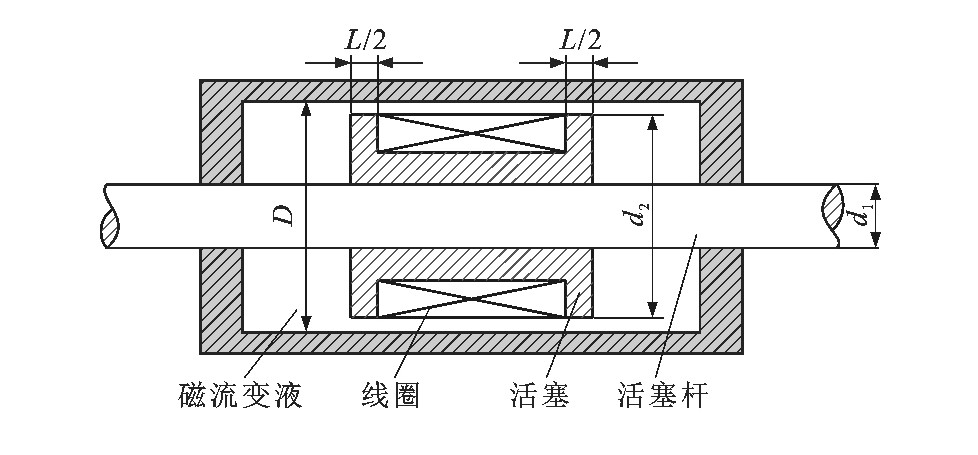Influence of parameters of magnetorheological damper on vibration attenuation effect of seat suspension system
-
摘要: 应用Bingham本构力学模型, 得到了磁流变阻尼器(MRD) 的结构尺寸参数(缸体内径、活塞直径、活塞杆直径、活塞有效长度)、线圈匝数和磁流变液表观黏度与输出阻尼力的关系, 利用力学模型分析了MRD的6个参数对输出阻尼力和动态范围的影响; 建立了基于MRD的半主动座椅悬架系统模型, 以驾驶人加速度和座椅软垫动行程的均方根作为减振效果的评价指标, 采用百分比斜率均方根评价MRD参数的影响程度; 结合Bingham本构力学逆模型, 分析了MRD的6个参数对减振效果的影响及MRD磨损对减振效果的影响。分析结果表明: 活塞直径对驾驶人加速度和座椅软垫动行程的影响因子分别为4.83、5.46, 缸体内径的影响因子分别为4.45、4.75, 线圈匝数的影响因子分别为0.61、0.67, 活塞杆直径的影响因子分别为0.53、0.59, 活塞有效长度的影响因子分别为0.51与0.56, 因此, 活塞直径对减振效果的影响最大, 其次为缸体内径, 随后依次为线圈匝数、活塞杆直径与活塞有效长度, 而磁流变液表观黏度对减振效果几乎没有影响; 为了获得较好的减振效果, 应使MRD的最大输出阻尼力与动态范围足够大。Abstract: The relationships among the output damping force and the structural dimension parameters (cylinder inner diameter, piston diameter, piston rod diameter, effective piston length), coil turn, and apparent viscosity of magnetorheological fluid of magnetorheological damper (MRD) were obtained based on the Bingham constitutive mechanical model.The effects of the six parameters of MRD on the output damping force and the dynamic range were analyzed by using the obtained mechanical model.A semi-active seat suspension system model based on MRD was established, and the RMSs of driver acceleration and dynamic displacement of seat cushion were used as the evaluation indexes of vibration attenuation effect, and the RMS of percentage-based slope was put forward to evaluate the influence degrees of MRD parameters.The influences of the six parameters of MRD on the vibration attenuation effect were investigated, and the influence of MRD wear on the vibration attenuation effect was analyzed simultaneously by using the Bingham constitutive inverse mechanical model.Analysis resultshows that the influence factors of piston diameter on the driver acceleration and the dynamic displacement of seat cushion are 4.83 and 5.46, respectively.The influence factors of cylinder inner diameter are 4.45 and 4.75, respectively.The influence factors of coil turn are 0.61 and0.67, respectively.The influence factors of piston rod diameter are 0.53 and 0.59, respectively.The influence factors of effective piston length are 0.51 and 0.56, respectively.So piston diameter has the most important influence on the vibration attenuation effect, the second is cylinder inner diameter, and then followed by coil turn, piston rod diameter and effective piston length.However, the apparent viscosity of magnetorheological fluid has little influence on the vibration attenuation effect.Besides, in order to obtain a better vibration attenuation effect, the maximal output damping force and dynamic range of MRD should be larger enough.
-
表 1 MRD主要参数值
Table 1. Main parameter values of MRD

-
[1] YAO H J, FU J, YU M, et al. Semi-active H∞control of seat suspension with MR damper[J]. Journal of Physics: Conference Series, 2013, 412 (1): 1-16. [2] 水奕洁, RAKHEJA S, 上官文斌. 剪式悬架座椅等效刚度阻尼的计算与分析[J]. 振动与冲击, 2016, 35 (19): 38-44. https://www.cnki.com.cn/Article/CJFDTOTAL-ZDCJ201619008.htmSHUI Yi-jie, RAKHEJA S, SHANGGUAN Wen-bin. Calculation and analysis for equivalent stiffness and damping of a scissor type seat-seat suspension-human body system[J]. Journal of Vibration and Shock, 2016, 35 (19): 38-44. (in Chinese). https://www.cnki.com.cn/Article/CJFDTOTAL-ZDCJ201619008.htm [3] MACIEJEWSKI I, GLOWINSKI S, KRZYZYNSKI T. Active control of a seat suspension with the system adaptation to varying load mass[J]. Mechatronics, 2014, 24 (8): 1242-1253. doi: 10.1016/j.mechatronics.2014.10.008 [4] BAI Xian-xu, PENG Jiang, QIAN Li-jun. Integrated semiactive seat suspension for both longitudinal and vertical vibration isolation[J]. Journal of Intelligent Material Systems and Structures, 2017, 28 (8): 1036-1049. doi: 10.1177/1045389X16666179 [5] GAD S, METERED H, BASSUINY A, et al. Multi-objective genetic algorithm fractional-order PID controller for semiactive magnetorheologically damped seat suspension[J]. Journal of Vibration and Control, 2017, 23 (8): 1248-1266. doi: 10.1177/1077546315591620 [6] MOHAN E, NATARAJAN U. Experimental investigation on boring tool vibration control using MR fluid damper[J]. Journal of Advanced Manufacturing Systems, 2016, 15 (1): 13-25. doi: 10.1142/S0219686716500025 [7] OREˇCN'Y M, SEGL'AŠ, HUˇNADY R, et al. Application of a magneto-rheological damper and a dynamic absorber for a suspension of a working machine seat[J]. Procedia Engineering, 2014, 96: 338-344. doi: 10.1016/j.proeng.2014.12.127 [8] 彭志召, 张进秋, 岳杰, 等. 具有并联常通孔的磁流变阻尼器设计与分析[J]. 机械工程学报, 2015, 51 (8): 172-177. https://www.cnki.com.cn/Article/CJFDTOTAL-JXXB201508025.htmPENG Zhi-zhao, ZHANG Jin-qiu, YUE Jie, et al. Design and analysis of magnetorheological damper paralleling with constant throttling orifices[J]. Journal of Mechanical Engineering, 2015, 51 (8): 172-177. (in Chinese). https://www.cnki.com.cn/Article/CJFDTOTAL-JXXB201508025.htm [9] LI Zhong-xian, LU Yang, XU Long-he, et al. Experimental studies on nonlinear seismic control of a steel-concrete hybrid structure using MR dampers[J]. Engineering Structures, 2013, 49 (2): 248-263. [10] HAN Xiao-ming, BO Yu-cheng, LI Qiang, et al. Design and analysis of magnetorheological dampers under impact loads[J]. Applied Mechanics and Materials, 2013, 295-298: 2045-2048. doi: 10.4028/www.scientific.net/AMM.295-298.2045 [11] HU Guo-Liang, LIU Qian-jie, DING Ru-qi, et al. Vibration control of semi-active suspension system with magnetorheological damper based on hyperbolic tangent model[J]. Advances in Mechanical Engineering, 2017, 9 (5): 1-15. [12] KARKOUB M A, ZRIBI M. Active/semi-active suspension control using magnetorheological actuators[J]. International Journal of Systems Science, 2006, 37 (1): 35-44. doi: 10.1080/00207720500436344 [13] DONG Xiao-min, YU Miao, GUAN Zhi. Adaptive sliding mode fault-tolerant control for semi-active suspension using magnetorheological dampers[J]. Journal of Intelligent Material Systems and Structures, 2011, 22 (15): 1653-1660. doi: 10.1177/1045389X11421815 [14] YU Miao, DONG Xiao-min, CHOI S B, et al. Human simulated intelligent control of vehicle suspension system with MR dampers[J]. Journal of Sound and Vibration, 2009, 319 (3-5): 753-767. doi: 10.1016/j.jsv.2008.06.047 [15] 李忠继, 戴焕云, 曾京. 基于磁流变阻尼器的铁道车辆模糊半主动控制[J]. 交通运输工程学报, 2014, 14 (5): 43-50. doi: 10.3969/j.issn.1671-1637.2014.05.006LI Zhong-ji, DAI Huan-yun, ZENG Jing. Fuzzy semi-active control of railway vehicle with magnetorheological dampers[J]. Journal of Traffic and Transportation Engineering, 2014, 14 (5): 43-50. (in Chinese). doi: 10.3969/j.issn.1671-1637.2014.05.006 [16] FERGANI S, SENAME O, DUGARD L. An LPV/H∞integrated vehicle dynamic controller[J]. IEEE Transactions on Vehicular Technology, 2016, 65 (4): 1880-1889. doi: 10.1109/TVT.2015.2425299 [17] 李占卫. 磁流变阻尼器的结构和性能研究[D]. 南京: 南京理工大学, 2012.LI Zhan-wei. Study on the structure and performance of MR damper[D]. Nanjing: Nanjing University of Science and Technology, 2012. (in Chinese). [18] STRECKER Z, MAZˇUREK I, ROUPEC J, et al. Influence of MR damper response time on semiactive suspension control efficiency[J]. Meccanica, 2015, 50 (8): 1949-1959. doi: 10.1007/s11012-015-0139-7 [19] HASSAAN G A. Car dynamics using quarter model and passive suspension, part V: frequency response considering driver-seat[J]. International Journal of Scientific Research Engineering and Technology, 2015, 4 (4): 357-365. [20] 任艳飞, 陈力奋. 磁流变阻尼器结构参数对汽车悬挂系统减振效果的影响与分析[J]. 振动与冲击, 2008, 27 (9): 76-78, 86. doi: 10.3969/j.issn.1000-3835.2008.09.018REN Yan-fei, CHEN Li-fen. Effect of MR dampers on shock absorption function of a vehicle suspension system[J]. Journal of Vibration and Shock, 2008, 27 (9): 76-78, 86. (in Chinese). doi: 10.3969/j.issn.1000-3835.2008.09.018 [21] DING Yang, ZHANG Lu, ZHU Hai-tao, et al. Simplified design method for shear-valve magnetorheological dampers[J]. Earthquake Engineering and Engineering Vibration, 2014, 13 (4): 637-652. doi: 10.1007/s11803-014-0269-2 [22] 蔡路, 涂奉臣, 潘亚嘉. 剪切阀式磁流变阻尼器实用设计方法研究[J]. 机械科学与技术, 2016, 35 (12): 1925-1929. https://www.cnki.com.cn/Article/CJFDTOTAL-JXKX201612021.htmCAI Lu, TU Feng-chen, PAN Ya-jia. Studying a simplified method of designing shearing valve type magneto-rheological fluid damper[J]. Mechanical Science and Technology for Aerospace Engineering, 2016, 35 (12): 1925-1929. (in Chinese). https://www.cnki.com.cn/Article/CJFDTOTAL-JXKX201612021.htm [23] KHAN S A, SURESH A, SEETHARAMAIAH N. Principles, characteristics and applications of magneto rheological fluid damper in flow and shear mode[J]. Procedia Materials Science, 2014, 6: 1547-1556. doi: 10.1016/j.mspro.2014.07.136 [24] CHUNG J U, PHU D X, CHO C H, et al. Comparison of damping force performance of MR dampers featuring flow and shear mode[C]//ICSV. The 22nd International Congress on Sound and Vibration. Florence: ICSV, 2015: 1-7. [25] NGUYEN Q H, CHOI S B, PARK Y G. An analytical approach to optimally design of electrorheological fluid damper for vehicle suspension system[J]. Meccanica, 2012, 47 (7): 1633-1647. doi: 10.1007/s11012-012-9544-3 [26] FERDAUS M M, RASHID M M, HASAN M H, et al. Optimal design of magneto-rheological damper comparing different configurations by finite element analysis[J]. Journal of Mechanical Science and Technology, 2014, 28 (9): 3667-3677. doi: 10.1007/s12206-014-0828-5 [27] 张志勇, 刘鑫, 黄彩霞, 等. 具有参数不确定性的车辆座椅悬架H∞输出反馈半主动控制[J]. 振动与冲击, 2013, 32 (14): 93-97, 147. https://www.cnki.com.cn/Article/CJFDTOTAL-ZDCJ201314017.htmZHANG Zhi-yong, LIU Xin, HUANG Cai-xia, et al. H∞output feedback semi-active control for a vehicle seat suspension with parametric uncertainty[J]. Journal of Vibration and Shock, 2013, 32 (14): 93-97, 147. (in Chinese). https://www.cnki.com.cn/Article/CJFDTOTAL-ZDCJ201314017.htm -





 下载:
下载:






















